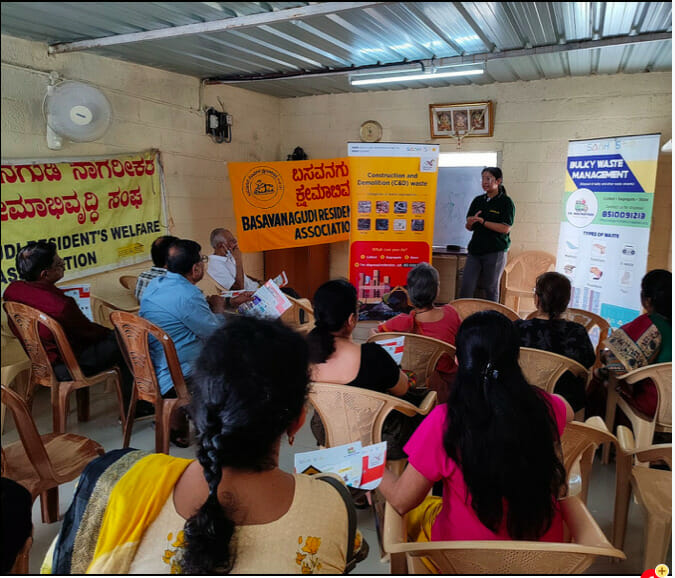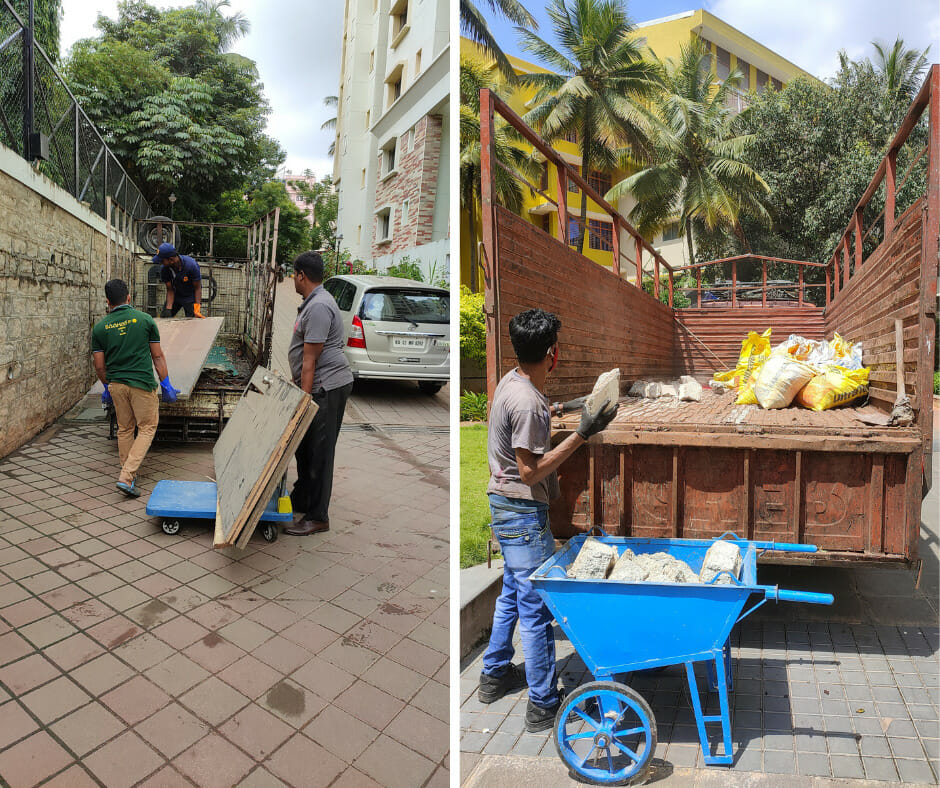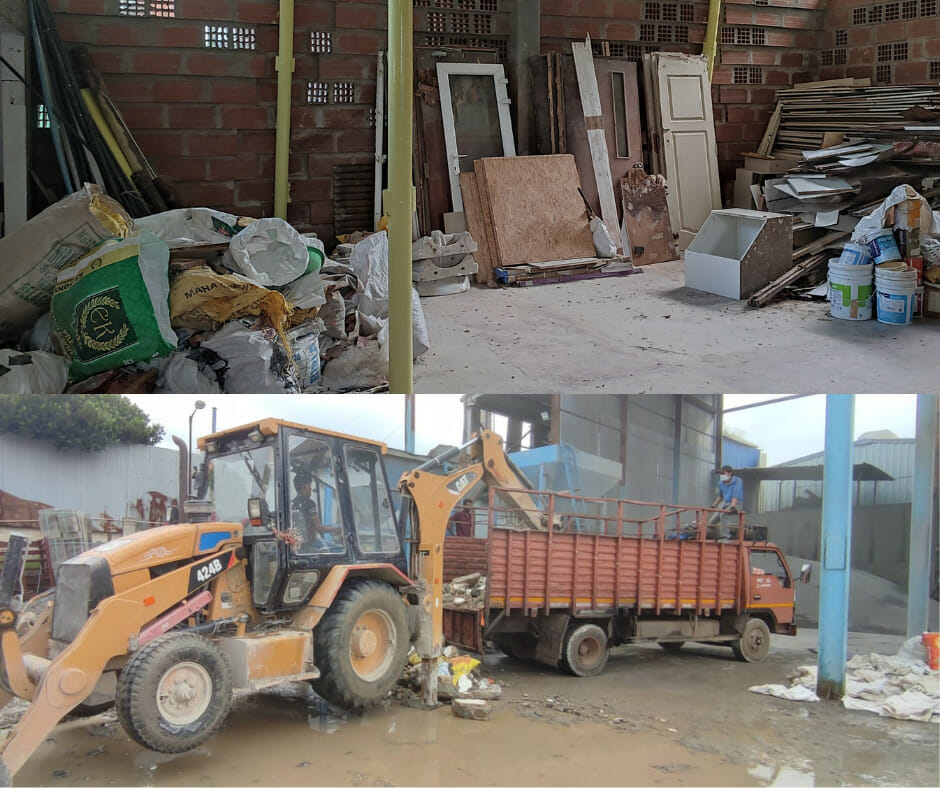The sight of piles of waste strewn on roads, footpaths, underneath flyovers, lake beds, and other vacant areas has become so common for Bengalureans that most of us don’t even notice what it consists of. It is waste, but all waste is not the same.
These piles comprise different types of waste. There is biodegradable waste, like food waste and paper, and non-biodegradable items, like plastics, metal, glass etc. However, a big volume consists of construction and demolition (C&D) waste, including concrete, stone debris, commodes, tiles etc. Have you wondered why this waste is dumped across the city and if citizens can do something about it?
It is estimated that around 3,500-4,000 tonnes of C&D waste is generated in Bengaluru everyday. The waste generators include large (bulk) generators, such as construction projects, metro, and government projects as well as small (non-bulk) generators, like house renovation and remodelling.
As per the C&D waste management rules 2016, issued by MoEFCC, it is mandated that bulk generators (which produce more than 20 tonnes/day or 300 tonnes/month per project) should have an approved waste management plan. It emphasises the need for bulk generators to segregate the waste into five categories: concrete, soil, brick and mortar, wood and plastic, and steel, and send it to authorised C&D waste processing units.
Read more: Where does construction waste go in Bengaluru?
Non-bulk generators
When it comes to non-bulk generators, the rules specifically mention that generators are responsible and have to bear the cost of segregation, storage, and proper disposal of waste. However, unlike municipal solid waste (MSW), there is no established collection system for the collection of C&D waste from non-bulk generators.
Citizens depend on the informal sector, where they pay tractor vendors for waste clearance, not bothering with where this waste is taken and what is done with it. Often, it is dumped illegally in the outskirts, around parks, waterbodies etc. Sometimes, for smaller quantities, generators themselves dump it along the roads, dump sites, empty plots, under flyovers, footpaths etc. as they are easy targets.
While the authorities are getting strict with the bulk generators, monitoring and addressing non-bulk generators remains a huge challenge. With a rapidly growing city and a poor collection and monitoring system, the problem of illegal dumping of C&D waste is becoming enormous.
Circular realty
Circular Realty by Saahas, an NGO, is the first of its kind project in India to address C&D waste collection from non-bulk generators. Funded under the CSR initiative of the Tata Housing Development Company, the project envisages creating awareness of C&D waste and bringing about behaviour change by providing responsible disposal options to citizens (non-bulk generators) of C&D waste. One of the key goals of this project is to ensure that the waste collected is sent to an authorised end destination to maximise recycling and resource recovery.
How is this achieved?
Creating awareness: Information, education, and communication (IEC) material has been created for raising awareness about C&D waste among citizens. Engaging content was developed for posters, flyers etc, along with campaigns on social media. Meetings were conducted with RWAs and the project was promoted and awareness created through public events.
Awareness sessions with RWAs, digital campaigns, and the setting up of information desks in public places are being carried out as part of the project. The objective of these activities is to disseminate information to the citizens on the negative impacts of C&D waste on the environment as well as human health, the importance of segregation, the need for proper management of C&D waste, and the recycling and reuse of C&D waste. With this, the project attempts to bring about behavioural change among citizens–an integral part of managing any kind of waste.

Read more: Understanding how to segregate waste
Collection system for non-bulk generators: A pilot collection system has been set up for Bengaluru South zone. Individuals/RWAs can reach out on the hotline number (8510091213) and place a pick up request.
Saahas team members visit the site to provide instructions on segregation categories and to ensure waste is segregated at the time of generation, instead of separating items from a mixed pile, which is time-consuming. Upon completion of the demolition/remodelling work, the segregated waste is collected.
The collected waste is taken to an aggregation centre in Koramangala, where it is aggregated and sent to the recycler periodically. Reusable materials like wooden doors, window frames, granite slabs etc. are donated to people for reuse.
In the last nine months (May 2022- January 2023), the project has carried out 63 collections of about 33.3 tonnes of C&D waste from individual households, of which 70% was put back to reuse or recycling.
Initially, the collection was provided for the residents of Bengaluru South, but with the dissemination of information regarding the project, citizens from other parts of the city have also started reaching out for proper disposal of their C&D waste. Saahas is providing subsidised collection services to locations that are within a reasonable distance from the aggregation centre.




‘Let’s talk about C&D waste: Non-bulk generator perspective’ – panel discussion: As part of the project, a panel discussion was conducted on October 14 2022 with the objective of creating awareness and discussing the challenges in handling and management of C&D waste by bringing various stakeholders together.
The panellists included representatives from Karnataka State Pollution Control Board (KSPCB), Sobha Concrete Products Limited, Bangalore Apartment Federation (BAF), National Law School of India University (NLSIU), and Saahas. The panel discussion was moderated by Meera K, co-founder, Citizen Matters.
The discussion focussed on aspects like problems faced by residents to dispose of their C&D waste, lack of guidelines on demolition, issue of transportation of waste, and less waste coming to processing plants.
It was highlighted, during the discussion, that aggregation centres at the zone/ward level and collection systems need to be set up by the municipal authorities to ensure waste reaches the recycling facilities. The event was well attended by members from Bruhat Bengaluru Mahanagara Palike (BBMP), think tanks, NGOs, students, and Solid Waste Management citizen activists.
With the growing attention on the need for effective management of C&D waste from citizens, activists, and organisations involved in the process. We hope to see improved participation of other stakeholders to address the proper management of C&D waste.